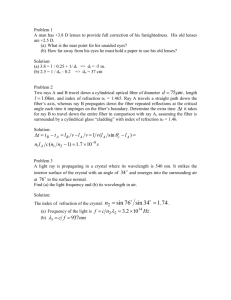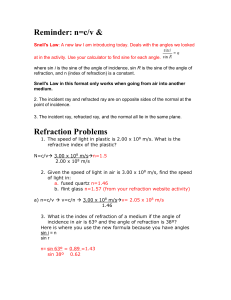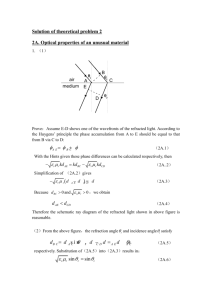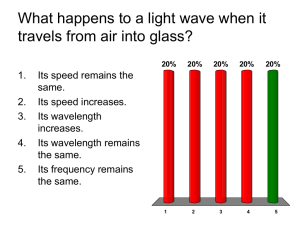Solution
advertisement
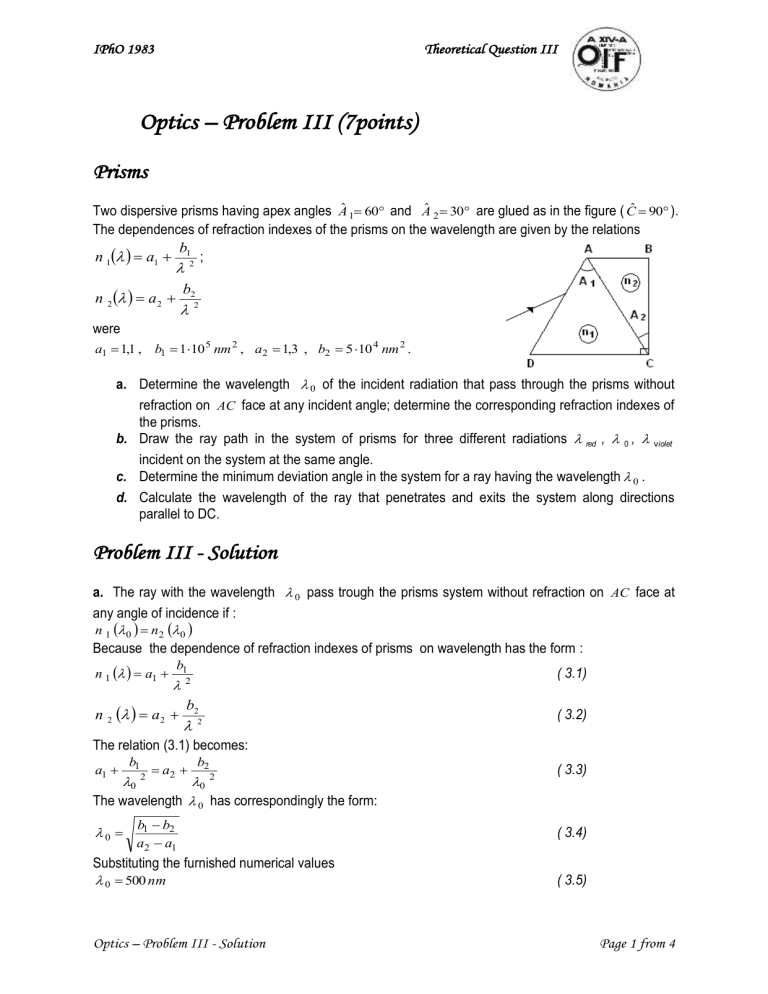
IPhO 1983 Theoretical Question III Optics – Problem III (7points) 3. Prisms Two dispersive prisms having apex angles Aˆ 1 60 and Aˆ 2 30 are glued as in the figure ( Ĉ 90 ). The dependences of refraction indexes of the prisms on the wavelength are given by the relations b n 1 a1 12 ; b2 n 2 a 2 2 were a1 1,1 , b1 1 10 5 nm 2 , a2 1,3 , b2 5 10 4 nm 2 . a. Determine the wavelength 0 of the incident radiation that pass through the prisms without refraction on AC face at any incident angle; determine the corresponding refraction indexes of the prisms. b. Draw the ray path in the system of prisms for three different radiations red , 0 , violet incident on the system at the same angle. c. Determine the minimum deviation angle in the system for a ray having the wavelength 0 . d. Calculate the wavelength of the ray that penetrates and exits the system along directions parallel to DC. Problem III - Solution a. The ray with the wavelength 0 pass trough the prisms system without refraction on AC face at any angle of incidence if : n 1 0 n 2 0 Because the dependence of refraction indexes of prisms on wavelength has the form : n 1 a1 b1 n 2 a 2 ( 3.1) 2 b2 2 ( 3.2) The relation (3.1) becomes: a1 b1 a2 b2 0 0 2 The wavelength 0 has correspondingly the form: 0 2 b1 b2 a2 a1 Substituting the furnished numerical values 0 500 nm Optics – Problem III - Solution ( 3.3) ( 3.4) ( 3.5) Page 1 from 4 IPhO 1983 Theoretical Question III The corresponding common value of indexes of refraction of prisms for the radiation with the wavelength 0 is: n 1 0 n2 0 1, 5 The relations (3.6) and (3.7) represent the answers of question a. ( 3.6) b. For the rays with different wavelength ( red , 0 , violet ) having the same incidence angle on first prism, the paths are illustrated in the figure 1.1. Figure 3.1 The draw illustrated in the figure 1.1 represents the answer of question b. c. In the figure 1.2 is presented the path of ray with wavelength 0 at minimum deviation (the angle between the direction of incidence of ray and the direction of emerging ray is minimal). In this situation Optics – Problem III - Solution Figure 3.2 Page 2 from 4 IPhO 1983 Theoretical Question III n 1 0 n2 0 sin where min A ' 2 A' sin 2 ( 3.7) m  ' 30 , as in the figure 1.1 Substituting in (3.8) the values of refraction indexes the result is min A ' 3 A' sin or 2 sin 2 2 3 2 ( 3.8) A' A' 2 2 ( 3.9) Numerically min 30,7 The relation (3.11) represents the answer of question c. ( 3.10) min 2 arcsin sin d. Using the figure 1.3 the refraction law on the AD face is ( 3.11) sin i1 n1 sin r1 The refraction law on the AC face is ( 3.12) n1 sin r1 ' n2 sin r2 Figure 3.3 As it can be seen in the figure 1.3 r2 A2 ( 3.13) and i1 30 ( 3.14) Also, r1 r1 ' A1 ( 3.15) Substituting (3.16) and (3.14) in (3.13) it results Optics – Problem III - Solution Page 3 from 4 IPhO 1983 Theoretical Question III n1 sin A1 r1 n2 sin A2 ( 3.16) or n1 sin A1 cos r1 sin r1 cos A1 n2 sin A2 ( 3.17) Because of (3.12) and (3.15) it results that sin r1 1 2 n1 ( 3.18) and cos r1 1 2 n1 ( 3.19) 4n1 2 1 Putting together the last three relations it results 4n1 2 1 2n2 sin A2 cos A1 sin A1 ( 3.20) Because Aˆ 1 60 and Aˆ 2 30 relation (3.21) can be written as 4n1 2 1 2 n2 1 ( 3.21) 3 or ( 3.22) Considering the relations (3.1), (3.2) and (3.23) and operating all calculus it results: ( 3.23) 4 3 a1 2 a 2 2 a 2 1 6 a1 b1 b2 2 a 2 b2 2 3 b1 2 b2 2 0 3 n1 2 1 n2 n2 2 Solving the equation (3.24) one determine the wavelength of the ray that enter the prisms system having the direction parallel with DC and emerges the prism system having the direction again parallel with DC . That is 1194 nm ( 3.24) or 1,2 m ( 3.25) The relation (3.26) represents the answer of question d. Professor Delia DAVIDESCU, National Department of Evaluation and Examination–Ministry of Education and Research- Bucharest, Romania Professor Adrian S.DAFINEI,PhD, Faculty of Physics – University of Bucharest, Romania Optics – Problem III - Solution Page 4 from 4
